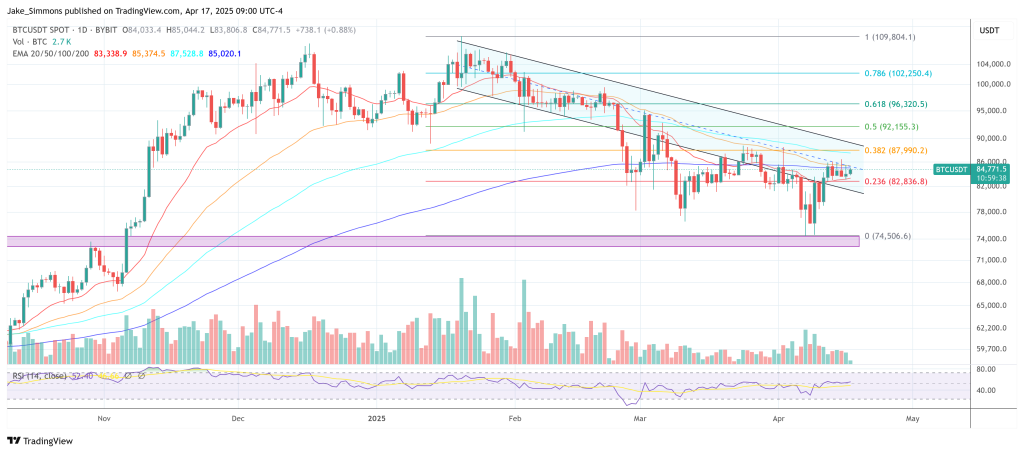
A quantum-computing consortium identified as Project Eleven has extended an open challenge to the worldwide cryptography community, presenting a reward of one Bitcoin to the first squad that can deconstruct a intentionally simplified version of Bitcoin’s elliptic-curve cryptography utilizing a true quantum computer before 5 April 2026.
Revealing what it terms the “Q-Day Prize” on X, the organization stated: “We have just initiated the Q-Day Prize. 1 BTC for the first team to decode a toy version of Bitcoin’s cryptography using a quantum computer. Deadline: April 5, 2026. Objective: Safeguard 6 M BTC (over $500 B).” This announcement encapsulates a worry that has lingered over the Bitcoin ecosystem for over a decade: the future emergence of large-scale, error-corrected quantum processors capable of executing Shor’s algorithm against actual keys.
Project Eleven is not requesting participants to directly breach Bitcoin’s 256-bit curve. Instead, teams are required to validate Shor’s algorithm against elliptic-curve keys ranging from one to twenty-five bits—lengths derisively termed “toy” by veteran cryptographers but still significantly beyond what has been publicly accomplished on tangible quantum processors. The organizers argue that even a breakthrough at the three-bit level would be “significant news,” as it would establish the first quantitatively verifiable benchmark of quantum advancement on the elliptic-curve discrete-log problem (ECDLP). In their own words, “No one has systematically assessed this risk yet.”
To be eligible, a submission must consist of gate-level code or explicit guidelines executable on actual quantum hardware, alongside a description of methods employed, error rates handled, and classical post-processing necessary. Hybrid strategies that rely on classical shortcuts are not permitted. All submissions will be disclosed, a decision the group frames as an exercise in radical transparency: “Rather than waiting for breakthroughs to happen behind closed doors, we advocate confronting this challenge directly, in a transparent and rigorous way.”
Why 1 Bitcoin—And Why Now?
Bitcoin’s security fundamentally relies on the difficulty of the discrete-logarithm problem over the secp256k1 curve. While classical assaults escalate exponentially, Peter Shor’s 1994 quantum algorithm could theoretically resolve the dilemma in polynomial time, reducing the cost from astronomical to merely enormous. Current investigations suggest that around two thousand fully error-corrected logical qubits—potentially supported by millions of physical qubits—would suffice to pose a threat to a 256-bit key. Companies like Google, IBM, IonQ, and newcomer QuEra are competing to achieve the four-digit logical-qubit milestone, albeit none has publicly showcased capabilities nearing that threshold as of now.
Project Eleven states that its prize serves more as a diagnostic than a bounty. More than ten million Bitcoin addresses, containing over six million coins, have already unveiled their public keys through past spending behavior. Should quantum technology surpass the critical threshold before those coins are transitioned to post-quantum addresses, the assets would be at risk of immediate theft. “Quantum computing is continuously advancing,” the group warns. “When that occurs, we must be prepared.”
The initiative emerges amidst a surge of quantum-resistance proposals within the broader Bitcoin ecosystem. Earlier this month, a group of developers proposed the Quantum-Resistant Address Migration Protocol (QRAMP), a Bitcoin Improvement Proposal designed to facilitate a network-wide transition to post-quantum key formats. Since QRAMP would necessitate a consensus-breaking hard fork, its political feasibility remains uncertain.
Independently, Canadian startup BTQ has introduced a novel proof-of-work alternative referred to as Coarse-Grained Boson Sampling, which would replace today’s hash-based mining challenges with photonic sampling tasks carried out on quantum hardware. Like QRAMP, BTQ’s proposal requires a hard fork and has yet to achieve wide support.
From a technical perspective, executing even a five-bit elliptic-curve variant of Shor’s algorithm is exceptionally demanding: qubits with fidelities exceeding 99.9%, coherent for hundreds of microseconds, and organized through advanced circuits involving thousands of two-qubit gates would be necessary. Error-correction overhead further exacerbates the engineering challenges, indicating that competitors will probably have to utilize small-code logical qubits and sophisticated compilation techniques just to manage noise levels.
Nonetheless, the prize could be irresistible for university labs and corporate research and development teams eager to highlight practical quantum advantages. Cloud-accessible systems from IBM’s Quantum System Two, Quantinuum’s H-series, and OQC’s superconducting platforms currently provide limited, pay-per-use access to dozens—or in IBM’s situation, hundreds—of physical qubits. Whether any of these devices can maintain the circuit depth required remains an open question.
Regardless of the outcome, valuable data will be produced. As articulated in Project Eleven’s inaugural tweet, the aim is clear: “Break the largest ECC key with Shor’s algorithm. The reward: 1 BTC + go down in cryptography annals.”
At the time of publication, BTC was trading at $84,771.

Featured image generated with DALL.E, chart from TradingView.com
 Editorial Process for bitcoinist focuses on delivering well-researched, precise, and impartial content. We adhere to rigorous sourcing standards, with each page undergoing thorough reviews by our team of leading technology experts and seasoned editors. This approach guarantees the integrity, relevance, and value of our content for our audience.
Editorial Process for bitcoinist focuses on delivering well-researched, precise, and impartial content. We adhere to rigorous sourcing standards, with each page undergoing thorough reviews by our team of leading technology experts and seasoned editors. This approach guarantees the integrity, relevance, and value of our content for our audience.





Be the first to comment